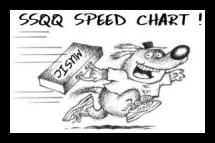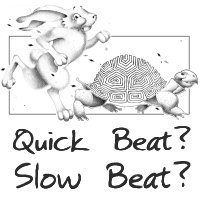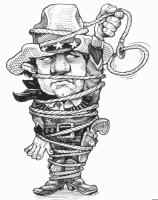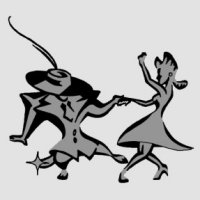TRIPLE STEP RANGE : 100
- 150 BPM
You must understand that I am
vastly oversimplifying throughout this article. First, unless you have a CD player nearby
and a watch with a second hand, some of what I write can be compared to explaining the
color spectrum to a blind man.
Second, there are countless nuances
and exceptions to my broad "ranges", but to explain them all would make this
article far too complicated. Now having said this, here is my first broad
generalization...
The TRIPLE STEP
RANGE contains music that has only one distinct beat
to count, but there may be a secondary "Syncopation Tempo"
If you hear a song that has
110 bpm, you are not likely to hear another range in the music of 55 bpm. Nor will
you typically hear a song of 220 beats. Music in this range has just one obvious
beat.
For example, the famous Eagles
song "Tequila Sunrise" is 111 bpm. There is just one obvious beat to count.
Since you probably don't have the song on in the background, I guess you will have to take
my word for it.
Yet at the same time, there is
definitely another tempo operating in the background. Unfortunately it is too faint to be
considered a "beat". This background sound is referred to as the
"Syncopation Tempo".
It is counted "1 and 2
and 3 and 4, and 1 and 2 and 3 and 4". The "1,2,3,4" form the
distinct beat while the "ands" are the syncopated beat. Dancers use these
syncopations for their Triple Step footwork.
Polka
is based on 6 steps to 4 beats of music. It is counted
"Trip le Step (1 and 2), Trip le Step (3 and 4)"
Cha Cha is based on 5 steps to 4 beats of music. It is counted
"Rock Step (2, 3), Cha Cha Cha (4 and 1)"
Jitterbug is based on 8 steps to 6 beats of music. It is counted
"Trip le Step (1 and 2), Trip le Step (3 and 4), Back Step (5, 6)"
Whip is based on 8 steps to 6 beats...
"Hitch Step Step (1 and 2), Travel Step (3 and 4),
Hitch & Bump (5 and 6)" |

|
If the footwork and timing
seem complex, you are correct. These dances are usually considered trickier to learn
because there is more footwork to keep track of than dances in the Slow / Quick Range.
More about that in a minute...
Uh Oh, Here's an
Exception !
Some very fast Swing music actually does
have a double range that sneaks into the Triple Step Range. Benny Goodman's Swing classic
"Sing, Sing, Sing" has a dual speed of 111 - 222 bpms. The Big Bad Voodoo
Daddy's have a 90's hit "Hoodoo Voodoo Doll" that clocks out at 240 bpms, but if
you listen carefully you can also count a background beat of 120 bpm. What is interesting
is the beat that is easier to hear is the faster one at 222 and 240. In "Mack the
Knife", the slower beat was easier to hear.
|
|
 |
Slow Slow Quick
Quick versus Triple Step
As a rule, all
music in the Slow/Quick range call for less footwork while all music in Triple Step range
call for more footwork.
Using Swing Dancing as an example, the
slower the music is, the more you must travel to "speed it up". The Triple Step,
Triple Step BackStep footwork of Jitterbug is used to create movement to make the dance
more energetic. However, as the music gets faster, people take fewer steps in order
to "slow down the music". Hence the Slow Slow Quick Quick footwork of Swing.
|
|
WESTERN MUSIC : Twostep
Each dance has a well-defined speed where
it "feels" the most comfortable. Most experienced dancers think a Twostep is
perfect around 90 (180) bpms. They believe slow Twosteps are 80 bpms and fast Twosteps go
up to perhaps 110 bpms. Certainly these numbers are flexible and may vary by dancer.
For example, as I am 50, music that I once
Twostepped to at age 30 like George Strait's "Ace in the Hole" at 114 bpms have
magically become Polkas. Interesting. Now how did that happen ?
Some people dance a Twostep at speeds as
slow as 70 bpm (aka 140 bpm). Personally I find this speed too slow although when I teach
I may use music that slow for my beginners. However when I DJ at the studio, I start my
slow Twosteps at 75 bpms and gradually build speed.
Around 93 bpm, students in the Beginning
Twostep class get overwhelmed while experienced Western dancers feel right at home.
Then at 99 bpm, you enter the Tweener Zone (100 - 110 bpm).
|
 |
|
THE TWEENER ZONE
(100 - 110 bpm)
At 99 bpm, you enter
an interesting speed range where you have a choice of dancing a fast Twostep or a slow
Polka. The Tweener Zone marks the transition of Twostep music into Polka music.
Using a color analogy, as red
becomes yellow, first it moves through orange. Think of the Tweener Zone as Orange. At
this speed you can either do a fast Twostep or a slow Polka. Students in the Beginning
Polka class are taught how to Polka to songs in this range while experienced dancers are
convinced all Tweener songs are actually Twosteps. This explains why students come to me
at practice night to ask why so and so is Twostepping to a song they did the Polka to in
class. Take your pick : it is perfectly okay to do either one.
Songs in this range are
perfect speeds for students in Intermediate Western Swing to practice their Polka-rhythm
double turns. In addition, many songs in this range are excellent Western Cha Chas.
|
POLKA MUSIC (100 -
135 bpm)
Polkas are a good practice
speed for Beginners or "relaxed dancers" from 100-110
(Garth Brooks "Neon Moon" at 105 bpm)
a perfect speed for
experienced dancers from 110-120
(George Strait's "Amarillo By Morning" at 117 bpm)
exercise at 120-126
(Suzy Bogguss' "I Want to be a Cowboy's Sweetheart at 126 bpm)
heavy breathing from
126-135
(Brooks and Dunn's "My Maria" at 129 bpm and
Charlie Daniel's "Devil Went Down to Georgia" at 135 bpm)
and sheer stupidity above that
(The "Orange Blossom Special" is 177 bpm. Now that isn’t fast, that’s
ridiculous !)
|
The DEAD ZONE (135
- 150 bpm)
The Dead Zone is Western music
recorded from 135 - 150 bpm. Music in this range is either too fast for Polkas or too slow
for Twosteps. For example, "Don't Rock the Jukebox" by Alan Jackson and
"Peaceful Easy Feeling" by the Eagles are both recorded around 72/144 bpm. Both
songs have the feel of a Twostep but lack the speed for Twostep to feel comfortable.
"How Do" by Mary Chapin Carpenter at 141 bpm feels like a Polka, but is
ridiculously fast. In my opinion none of these songs works worth a darn. Have
a beer.
|
WESTERN TWOSTEP FOOTWORK
VERSUS POLKA FOOTWORK
The whole point of footwork is
to make dancing to a particular speed of music enjoyable. Interestingly Twostep footwork
is designed to speed you up ! For ease of explanation, if George Strait's Twostep
classic "Fool Hearted Memory" is 90 bpm while "Red Neck Girl" by the
Bellamy Brothers is 120 bpm. If you used the same footwork to both songs, you would have
trouble keeping up with the beat.
If you study Twostep dancers,
they pass their feet. This technique speeds up their momentum. Polka dancers use a
step-close-step footwork that decelerates their momentum. The purpose of Polka footwork is
to use more steps than Twostep, but actually to slow you down.
JITTERBUG FOOTWORK
VERSUS SWING FOOTWORK
Swing Dancing uses just the
reverse technique than Western Dancing. The difference is that Western Dancing travels
while Swing stays in one spot on the floor.
Twostep uses fewer steps than
Polka, but by passing each step, momentum is increased. Polka may have more steps than
Twostep, but since the steps don't pass, the momentum is actually reduced.
Now in Swing Dancing, the
slower the music is, the more you must travel to "speed it up". The whole idea
of the extra footwork is to cover more ground to create more momentum. When the Swing
music gets faster though, the Step Step Back Step of Swing reduces momentum by taking
fewer steps and traveling less.
I told you it gets
complicated.
|
SWING MUSIC
Jitterbug/Lindy (132 - 150 bpm)
Buddy Holly's "That'll Be
the Day" is 132 bpm. Many hits of the 50's were recorded at similar speeds such as
the Clovers "Love Potion #9", the Dell Vikings "Come Go with Me", and
the Crew Cuts "Sh Boom". This era was noted for many Swing dances like the Bop,
the Boogie Woogie, and the Jitterbug that all used Triple Step footwork. The speed of the
music dictated what sort of footwork would feel most comfortable to dance to.
|
 |
Swing Time ! (150 - 200 bpm)
Almost all the great Swing classics we
cherish from the Big Band Era reside in the Swing Range. "In the Mood" by
Glenn Miller is 162 bpm, "Take the A Train" by Duke Ellington is 162 bpm,
"Boogie Woogie Bugle Boy" by the Andrews Sisters is 192 bpm, "Let's
Dance" by Benny Goodman is 180 bpm, and the great dance song "Hooked on
Swing" by Larry Elgart is 174 bpm.
As mentioned earlier, The Triple Step,
Triple Step, BackStep footwork of Jitterbug at the slower tempos is used to create
movement to make the dance more energetic. However, as the music gets faster, people
take fewer steps in order to "slow down the music". That is why the faster Swing
tempos have only 4 steps (slow slow back step). Jitterbug’s 8 steps speed up the
music, Swing’s 4 steps slow the faster tempos down.
However some of you ladies who have been in
my Swing classes may recall that a frequent use of the Triple Step to almost any song
except the very fastest results in a much flashier dance performance. The man on the other
hand almost never triple steps except to the slowest of songs. Instead most advanced male
swing dancers use a variation called "tap-step, tap-step, back step".
|
Fast Swing 200 - 240
Much of the 90’s Swing music is
recorded in the 200’s range. That is brutally fast ! Ain't no Triple Steppin'
at these speeds, that is for sure. However, the dancing is definitely flashy !
The secret to dancing at these speeds is to
take small steps and to use arm tension on the back step to help control momentum. Only a
great deal of practice will allow you to keep the beat at these speeds.
|
As we reach the conclusion of our article on the Speed of Music, Page 3 will
cover information on Waltz, Whip, Latin, and Ballroom dancing. In addtion we will answer
the burning question of why there seem to be at least two dances for each type of music.
|

|
|